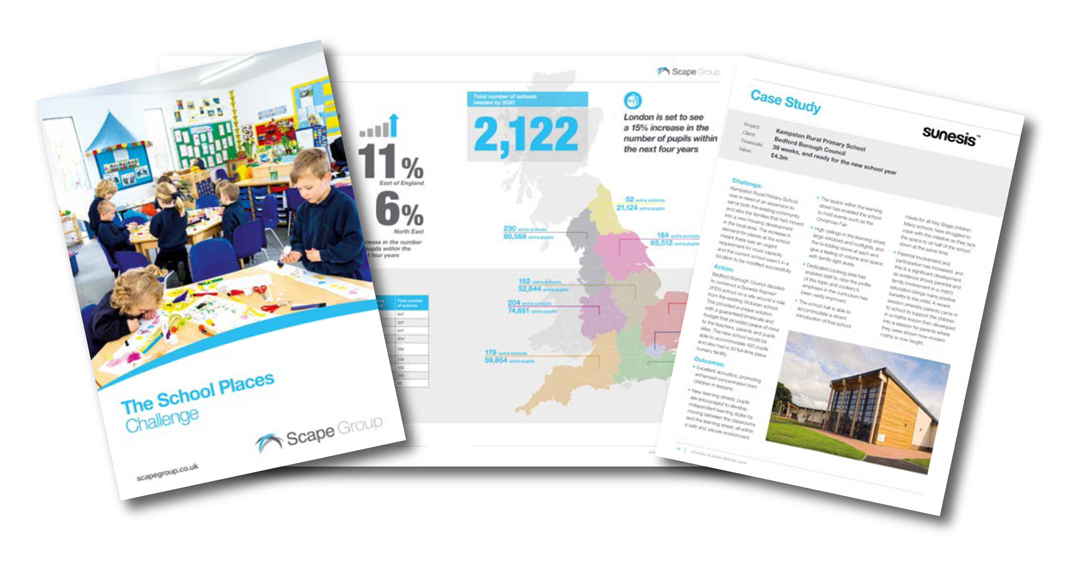
Over 24,000 extra classrooms required by 2020 as population booms and more than 2,000 new schools must be built within the next four years to accommodate the rising number of primary and secondary school pupils, that’s according to new report The School Places Challenge. Research suggests that to meet the shortfall two new schools must be created every day.
New research from Scape Group, the public sector owned built environment specialist, has revealed the full extent of the school building challenge in England, as the equivalent of 24,287 classrooms or 2,122 new schools must be built before 2020 to meet the growing numbers of primary and secondary school pupils.
Local authorities are estimating there will be an additional 729,000 primary and secondary school pupils by 2020.[1] The number of primary school pupils in England will rise 8.6% by 2020, but the greatest growth will come from secondary school pupils, set to increase 12% rise by 2020.
The rise in pupil numbers will require many more schools to be built across the country, with a surge in primary pupils beginning to move into secondary schools. Across England, local authorities will have to find space for the equivalent of 12,209 additional primary classrooms, which equates to 1,744 single form entry primary schools. A further 12,078 secondary classrooms or 378 new secondary schools will be needed to match the rising numbers.
Mark Robinson, chief executive of Scape Group, commented: “The country will soon start to feel the full weight of the impending boom in pupil numbers, and we’re already seeing unprecedented pressure on school places. A radical new wave of school-building must be a top priority for government.”
School Building Challenge: England’s Regions
Every region of England will see growth in both primary and secondary numbers, but the impact of England’s rising population on school places will be greater in some regions than others. London, the South East and East of England are set to see the highest growth, while the North East and North West will see more modest increases.
England’s fastest growing boroughs
Outside of London the Northern Powerhouse city of Manchester will see the largest rise in pupil numbers, with almost 19,000 extra primary and secondary pupils by 2020, a 27% increase. This will require the equivalent of 57 new schools — 48 primary schools and nine new secondary schools in just four years.
The cities of Bristol, Peterborough, Milton Keynes, Leicester and Nottingham will also see rapid growth requiring new school building. Peterborough’s 21% growth in pupils will require 20 brand new schools, while Milton Keynes’ 19% increase will require 27 new schools.
The districts of Reading, Slough and Bracknell in London’s commuter belt will also see significant growth as the capital’s growing population spills out across the M25, with pupil numbers rising by 25%, 20% and 18% respectively.
London pupil surge
The capital will see a 15% increase in primary and secondary school populations by 2020, meaning an additional 170,943 pupils and requiring 507 new schools. Of these, 421 would be the equivalent of 1FE primary schools and 86 would be secondary schools.
There will be wide variation in pupil population growth and school building requirements across London’s boroughs. The London Borough of Barking and Dagenham will see the biggest increase in pupil numbers – an increase of 28% by 2020, requiring 28 new schools. The nearby borough of Newham, also in East London, will need to build the most new schools in London – 37 by 2020 to accommodate over 12,000 extra pupils.
However, the Royal Borough of Kensington and Chelsea will see a decline in primary school population of 2% by 2020, creating spare capacity in its schools. In North London, the boroughs of Haringey and Camden will see growth rates that are relatively low for England, at 6.8% and 6.7% respectively. The average increase for all pupils across England is much higher at 9.9%.
Knock-on effect
Mark Robinson continued: “As the growth of the primary school population gathers pace, the pressure on school places will soon transfer to the secondary population, requiring a new wave of advanced school building. The Government’s preference for free schools has created uncertainty for local authorities, who are tasked with planning and building new schools, but will not be responsible for running them. Proposals for new grammar schools has further muddied the waters.
“Leaving the EU could have a profound effect on the UK population — we could see a short-term surge in migration from Europe or a drop off in numbers if migrants are put off coming here. It is very difficult to predict what impact Brexit will ultimately have, putting even more pressure on local authorities who are planning how and where to prioritise school-building.
“In a post-Brexit economy, with all of the uncertainty this brings, the construction of new schools must be a top priority for government and local authorities must be given the tools and funding necessary to deliver extra places in time. Creative solutions including standardised design, classroom extensions and larger ‘super-schools’, as well as more effective use of land to deliver mixed-use developments, are all options we need to look at to deliver more new schools.”
Duncan Green, Perfect Circle chairman, commented: “The influence of the free schools programme, ongoing academisation and constrained education budgets means local authorities, Academy Trusts and other education providers are, in some places, struggling to adapt and keep pace with the changing market. However, the positive trend we have seen in the past year is one of collaboration. Local authorities have begun to embrace the free school programme, working in partnership with small and large free school trusts to ensure a joined-up approach is taken on new school provision.
Andrew Alsbury, Willmott Dixon education director, added: “The continued and urgent need for a well-planned long-term solution to meet rising school place demand in the face of increasing pressure on capital budgets is one of our biggest challenges over the next decade. It needs a joined-up approach between the public and private sectors, as well as local and central government to bridge the gap.”
The full report, The School Places Challenge, can be downloaded from: www.scapegroup.co.uk/research








